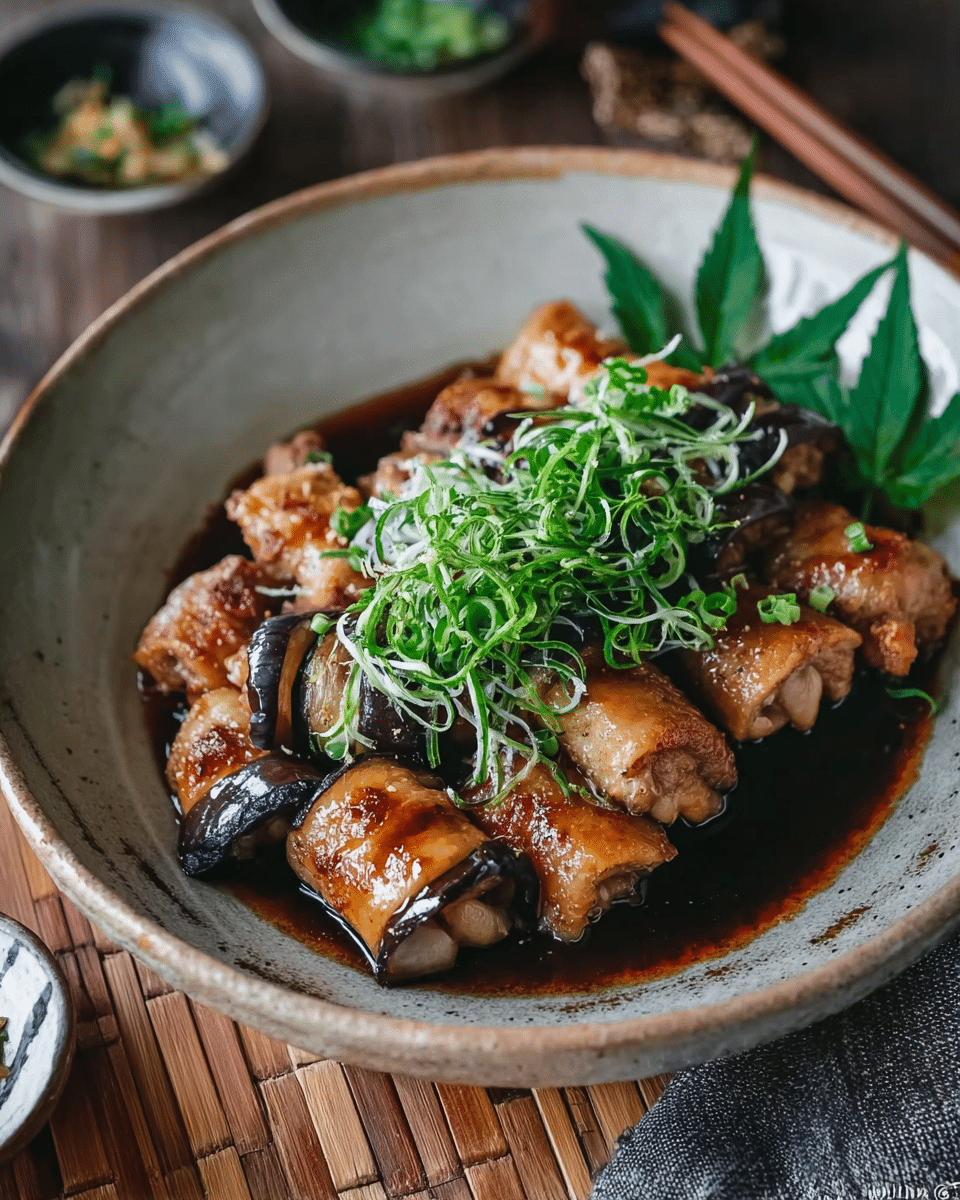These Ginger Pork Rolls with Eggplant are a perfect example of comforting Japanese home cooking. Thin slices of pork are wrapped around tender eggplant sticks, then pan-fried and coated in a savory-sweet ginger soy sauce. The dish is light, flavorful, and bento-friendly, making it ideal for weeknight dinners or meal prepping. Garnished with shiso leaves and optionally served with yuzu kosho for a spicy citrus kick, this meal delivers big flavor with minimal fuss.
Full Recipe:
Ingredients
Main Ingredients:
-
2 Japanese eggplants (or 1 long Chinese eggplant, 10 oz / 280g)
-
½ lb thinly sliced pork loin (shabu shabu meat)
-
2 Tbsp potato starch or cornstarch
Seasoning Sauce:
-
½ tsp grated ginger (with juice)
-
2 Tbsp soy sauce
-
2 Tbsp mirin
-
1 Tbsp sake (or water)
-
1 tsp sugar
For Cooking:
-
1 Tbsp toasted sesame oil
-
½ tsp miso
Garnish (optional):
-
4 shiso leaves (perilla/ooba), cut into chiffonade
-
Yuzu kosho (Japanese citrus chili paste)
Directions
-
Prepare the ingredients:
-
Peel eggplants and slice into sticks. Soak both the eggplant sticks and julienned peels in water to reduce bitterness and prevent discoloration.
-
Grate ginger and mix with soy sauce, mirin, sake, and sugar to make the sauce.
-
-
Assemble the pork rolls:
-
Wrap two eggplant sticks with each pork slice.
-
Coat both sides of each roll lightly with potato starch. Shake off excess.
-
-
Pan-fry:
-
Heat sesame oil in a nonstick pan over medium heat.
-
Add rolls and brown on all sides. Cover and cook for 2–3 minutes until eggplant is tender.
-
-
Add sauce and finish:
-
Pour the ginger-soy sauce over the rolls. Rotate and spoon sauce over the top to coat.
-
Remove rolls to a plate and pour sauce over them.
-
-
Cook eggplant skins:
-
In the same pan, add eggplant skins and miso. Cook on medium-low heat for 2–3 minutes. Place on top of rolls.
-
-
Garnish and serve:
-
Sprinkle with shiso chiffonade and a touch of yuzu kosho if desired. Serve with steamed rice.
-
Nutrients
Per serving (2 servings total):
-
Calories: 304 kcal
-
Carbohydrates: 20g
-
Protein: 29g
-
Fat: 9g
-
Saturated Fat: 2g
-
Sugar: 10g
-
Fiber: 5g
-
Sodium: 775mg
-
Cholesterol: 75mg
-
Potassium: 862mg
A Celebration of Washoku Simplicity
Washoku, the traditional culinary practice of Japanese cuisine, emphasizes seasonal ingredients, harmony of flavors, and minimal waste. This recipe is a shining example of that philosophy. Eggplant—a common summer vegetable in Japan—is used in its entirety, with even the skins cooked and served atop the dish. Pork, while not as prominently featured in traditional Japanese cuisine as fish, has long been embraced in home-style dishes like shogayaki (ginger pork), which this dish closely resembles in spirit and flavor.
The seasonings—soy sauce, mirin, sake, sugar, and ginger—form a classic Japanese sauce base known for its umami-rich, sweet-savory profile. This balance of depth and brightness is what makes dishes like these both familiar and addictive.
The Perfect Pairing of Pork and Eggplant
Pork and eggplant are a beloved pairing in many East Asian cuisines, and for good reason. The mild, absorbent nature of eggplant makes it an ideal partner to fatty meats and strong seasonings. In this dish, Japanese or Chinese eggplants—known for their thin skins and tender flesh—are peeled, sliced into sticks, and wrapped in thinly sliced pork loin. This wrapping technique not only ensures even cooking but also protects the delicate eggplant from overcooking or drying out.
Once pan-fried, the exterior of the rolls becomes crisp and caramelized, while the eggplant inside turns creamy and soft. The contrast is delightful and visually appealing, especially when topped with vibrant garnishes like shiso leaves or the glossy sauce reduction.
The Flavorful Ginger-Soy Sauce
The sauce is where this dish really comes alive. Grated ginger, along with its juice, is combined with soy sauce, mirin, sake, and sugar to create a glaze that’s at once punchy, sweet, and warming. As the sauce hits the hot pan, it thickens slightly and adheres to the rolls, infusing them with flavor and moisture.
Ginger, with its invigorating zing, serves as the dominant flavor note, making the dish feel both comforting and fresh. Mirin adds sweetness and gloss, while sake provides depth and a subtle aroma. The sugar rounds it out, keeping the flavors balanced rather than overly salty or sharp.
By spooning the sauce over the rolls during cooking, each piece becomes lacquered with this deeply savory glaze—a hallmark of many Japanese home-cooked meals.
Textural Details and Garnish Magic
The addition of miso-sautéed eggplant skins may seem minor, but it’s an example of thoughtful cooking that honors the whole ingredient. These skins, when cooked separately with a bit of miso, take on a savory-salty richness that complements the sweet soy glaze on the rolls. They’re placed atop the finished dish, adding both texture and flavor while minimizing waste.
Garnishing with fresh shiso leaves introduces an herbal, minty brightness that lifts the dish’s rich tones. Shiso (or perilla) is often used in Japanese cuisine to provide contrast, and its subtle citrus-anise note pairs wonderfully with the pork and ginger.
For those who enjoy a spicy twist, a dab of yuzu kosho—a paste made from chili peppers, yuzu zest, and salt—adds a bright, fiery note with a hint of citrus. This optional condiment enhances the flavor complexity and offers a traditional Japanese way to add heat without overpowering the dish.
A Bento and Meal Prep Hero
One of the standout benefits of this dish is its suitability for advance preparation. Ginger Pork Rolls reheat beautifully and maintain their structure and flavor even after chilling, making them an excellent choice for bento lunches or meal planning. Packed alongside steamed rice, pickled vegetables, or blanched greens, they offer a balanced, protein-rich meal with minimal fuss.
Because they’re already portioned into neat rolls, they fit well into containers and can be easily scaled up or down depending on how many servings you need. The sauce, once thickened and reduced, helps keep the meat moist, while the eggplant continues to mellow and soften as it rests.
Nutritional Balance and Wellness Appeal
Despite its comforting nature, this dish is surprisingly light and nutrient-rich. With only about 300 calories per serving, it offers an excellent balance of lean protein (29g per serving), moderate healthy fats, and complex carbohydrates (if served with rice or vegetables). The use of sesame oil provides heart-healthy fats and a rich, nutty undertone.
Eggplants are high in fiber, potassium, and antioxidants such as nasunin, which supports brain health. Ginger, a known anti-inflammatory, aids digestion and adds functional benefits to the dish. The low sugar and minimal saturated fat make it a wholesome choice for those aiming for balanced, everyday meals.
Cooking Tips and Variations
To achieve the perfect sear, make sure to pat the pork dry before rolling and avoid overcrowding the pan. Using a nonstick skillet allows for even browning without excess oil, while sesame oil adds that signature Japanese nuttiness. If you prefer a crispier exterior, you can briefly finish the rolls under a broiler or torch them lightly for a touch of char.
For a vegetarian variation, thin strips of firm tofu or seitan could be used to wrap around the eggplant, or the pork can be replaced with thin-sliced mushrooms like king oyster or shiitake for an earthy spin.
You can also change the base seasoning slightly: adding a splash of rice vinegar for extra tang, a pinch of chili flakes for heat, or experimenting with white miso in the sauce for a creamier finish.
Conclusion
Ginger Pork Rolls with Eggplant are a shining example of how thoughtful, minimalist cooking can result in deeply flavorful, satisfying meals. With their perfect balance of sweet, savory, and spicy notes, and a delightful contrast in textures, these rolls are both comforting and elegant—ideal for a weeknight dinner or a sophisticated bento.
Rooted in the traditions of Japanese home cuisine, they demonstrate how a few pantry ingredients, when treated with care and precision, can create something truly nourishing and memorable. Whether enjoyed hot off the pan or cold the next day, these rolls offer a bite-sized taste of culinary harmony—where simplicity meets depth, and every component is made to shine.

